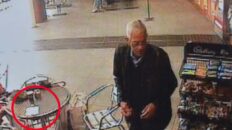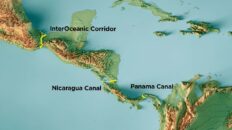In the late 70’s and early 80’s, a wave of unexplained deaths swept through Laotian immigrant communities in the US. Efforts to solve the mystery, sparking a mystery that traces back to a secret Vietnam-era CIA operation and bombing campaign. And along the way, inspired one of the most iconic horror villains of all time.
TRANSCRIPT:
If you saw my video on the disease that inspired A Nightmare On Elm Street, you caught a little bit about the plight of the Hmong people following the Laos Civil War. If you haven’t seen it, I encourage you to watch it, it’s here on Nebula, but I talk about the bombing campaign that the US engaged in during the Vietnam War.
To just call it a “bombing campaign” would be like calling the Black Plague a minor case of the sniffles. It was a relentless onslaught of destruction that is almost impossible to even conceptualize.
The sheer numbers involved are beyond staggering, but just to repeat what I said in the previous video. Two million tons of munitions, equating to roughly 260 million bombs were dropped on the country of Laos, the equivalent of a planeload of bombs every eight minutes 24 hours a day for 9 straight years. Laos is recognized as the most bombed country in the history of the world.
And this wasn’t even the country we were at war with, in fact, the entire operation was basically illegal because Laos had signed a neutrality agreement in the Vietnam War.
And yet, all that just scratches the surface of what happened in Laos, and specifically for the Hmong people that suffered the worst of the tragedy.
So in this Forgotten Atrocities video I’m going to go a bit deeper into the bombing and eventual genocide that decimated the country of Laos. And for my American viewers you should be forewarned that for the first time in this series… We’re the baddies.
It will most likely not be the last time.
First let’s get our bearings.
Laos is situated in the Indochinese Peninsula, sandwiched between Vietnam and Thailand, with Cambodia to the South. And right up there at the very north, communist China.
This whole peninsula was a French colonial territory beginning in the late 19th century. French missionaries first arrived in the area in the 1600s, and as their influence grew, the French government sent military to provide protection, while engaging in a little regime change in the various kingdoms of the area along the way.
By the 1860s, they controlled the majority of modern day Cambodia, which expanded up the east side of the peninsula in what would be Vietnam by the mid 1880s, then expanded east across Laos and into Thailand, then called Siam, at its peak around the turn of the century.
While some of these encroachments were welcomed by the reigning rulers of the time, various insurgencies and revolts pushed back against the French, so it was always an uneasy situation. I’m skipping over a lot of details here but suffice to say as the 20th century progressed, these insurgencies – some of them by communist groups – began to chip away at French influence in the region.
Following World War 2, all of this tension finally culminated in the First Indochina War, which lasted from 1947-1950, which the French lost. The Geneva Conference of 1954 put the final nail in the coffin and gave full autonomy to the peninsula.
But as always happens in a power vacuum, the peninsula splintered as various entities jockeyed for control, many of whom were communist groups, funded by the Soviet Union, who saw it as their mission to spread communism as far and wide as possible, and China, who had officially embraced communism in 1949 following a brutal civil war.
By the time the French left the area, North Vietnam was already under control of communist forces, with strongholds taking root in Laos and Cambodia as well.
Meanwhile the US government was watching anxiously as this communist ideology spread. What started in the Soviet Union, who had just taken in a massive amount of Eastern Europe after the war, had now spread to the second largest and most populous nation on Earth, and was creeping south toward India in rapid succession.
The feared “domino theory” seemed to be coming true, and US leaders foresaw a future where an entire half of the planet was under communist rule. With the Soviets now building nuclear weapons en masse, and the Cold War in full swing, the US looked for ways to intervene in Indochina, without, you know, “intervening.”
Enter the CIA.
As early as 1957, the CIA and US military began covert operations to fund, arm, and train anti-communist forces in Vietnam and Laos.
While Vietnam had already “settled” – for lack of a better word – into a communist controlled north and western-backed south, Laos was still in the midst of a civil war following the French occupation.
The three major groups vying for power were the pro-Vietnam communist group, the neutralists, and the royalists, each led by a prince that descended from various kingdoms in the area. They became known as the Three Princes and eventually formed a Tri-coalition government in 1962.
Guess which of these three princes the United States was most concerned with.
Prince Souphanouvong (soup-ON-uh-vong) was a freedom fighter against the French in his early days and sought the help of the communist Viet Minh forces in Vietnam, led by Ho Chi Minh.
He was so impressed by Ho Chi Minh that he returned the Laos and helped found the communist Lao Issara group, who fought to get rid of the French. This group was rather short-lived and after the French were ousted, he spun off a more radical group called the Pathet Lao. This group… was not so short-lived.
The Pathet Lao became closely associated with the North Vietnamese. They were equipped and trained by them and even received marching orders from them, not just in Laos but against anti-communist forces in Vietnam as well. They were in a sense a branch organization of the Viet Minh in many ways.
They also helped maintain the Ho Chi Minh trail, which was a supply route that ran alongside the Vietnam border within Laos. It was used by the North Vietnamese to equip communist forces in South Vietnam, also known as the Viet Cong.
It was this rise in power and assistance to communist North in Vietnam that got the attention of the US government. And by 1961, Operation Momentum was underway.
The CIA specifically recruited an ethnic group in Laos called the Hmong. The Hmong were an ethnic group that had originated in China and lived in the remote mountains of Laos
They had a history of evading authority and were very poor. They had been at odds with the lowland Lao majority for centuries, and the CIA exploited this history of conflict to their benefit.
The CIA trained the Hmong people under Operation Momentum, a training program to give the Hmong people the guerrilla war tactics they needed to fight the communist Laos military.
Even as Operation Momentum expanded and spread throughout Laos, the burgeoning war in Vietnam became the focus of the American effort; the Laotian Civil War was second to it.
THEN in 1962, the International Agreement on the Neutrality of Laos was signed. All foreigners had to leave including the secret CIA munitions. Without the CIA The Hmong joined the Royal Lao Army regulars in joint operations.
They were forced to fight in fixed positions something they weren’t trained for, many died as a result. It’s estimated that by 1973, the Hmong had suffered 18,000 to 20,000 soldiers killed in action, with an additional civilian Hmong death toll nearing 50,000.
So the Hmong, a mountain dwelling group who mostly kept to themselves, were brought into this flashpoint of the Cold War and left to their own defenses, under the leadership of General Vang Pao.
As the 60s progressed, the US became more embroiled in the ground war in Vietnam and, hamstrung by the Laotian neutrality agreement, turned to another tactic – just bombing them to smithereens.
With Kennedy’s assassination in 1963, the US went all-in on the Vietnam War through the Johnson and Nixon administrations. And even though Laos was supposed to be neutral territory, our presence there began to escalate under the advice of National Security Advisor Henry Kissinger.
In 1964, the US began Operation Barrell Roll in North Laos, it was a targeted bombing campaign to hammer the Pathet Lao. And later in 1965, began Operation Steel Tiger, which dropped bombs on the Ho Chi Minh trail in the southeast.
And yeah, as I said at the beginning, this was a level of bombardment that had literally never been seen before in human history. And somehow, these 260 million bombs were all dropped in secret.
By the way, many of those bombs fell on an area known as the Plain of Jars in Northern Laos, this is an ancient site that features hundreds of large stone “jars” that served as burial spots that date back to as far as 1240 BCE. These are obviously priceless archeological sites and yeah, a LOT of them got destroyed in the bombing of Laos.
In fact, the Plain of Jars is now a UNESCO World Heritage site, but only a handful of them can be visited because to this day there are thousands of unexploded bombs littering the landscape.
Laos is often called The Secret War, because internationally they were supposed to be neutral in the Vietnam conflict – they were still engaged in their own civil war during all of this. But both the North Vietnamese and the US ignored the neutrality order and used the country of Laos as a proxy to their own war, which was itself a proxy war.
And it was a weird situation because the US wanted to point out that the North Vietnamese were violating the neutrality agreement, but doing so would expose us for doing the same thing. So under Kissinger’s orders, they just kept on bombing. And this continued until 1974.
With the fall of Saigon in April of 1975, the Vietnam War came to an end and the US forces began to withdraw from the region. And while the communist North Vietnamese took control of the south, the same thing happened in Laos, with the Pathet Lao taking control of the country. And this is when the blowback against the Hmong people began.
On May 14 & 15 1975, a belated U. S. Air evacuation removed 2,500 Hmong to Thailand. But the majority of the surviving pro-American Hmong were left abandoned to face the wrath of the Pathet Lao, who carried out a minor genocide against the Hmong people for working with the Americans. Whole villages were destroyed, families were pulled from their homes and murdered in a wave of violence that mirrored that of the killing fields of Cambodia to the south.
Waves of Hmong refugees fled to Thailand, and many eventually immigrated to the United States.
And yeah, when they got here, they weren’t exactly welcomed with open arms. How immigrants get received in the US is always a mixed bag, but with the country still healing from the turmoil of the Vietnam War, many of the Hmong were looked at as communist refugees, which obviously they were the exact opposite of that, they were fighting with us – against the communists.
So when we talk about the PTSD that may – or may not – have led to the epidemic of SUNDS deaths, that’s what we’re talking about – 30 years of constant conflict. First against the French colonizers, then used as pawns in a struggle against the communists, and finally being the recipient of the most absurdly intense bombing campaign in human history.
But through it all the Hmong immigrants in the United States have emerged as a close-knit and vibrant community who have managed to maintain their cultural identity while forging a new one. Many of whom are carrying on their mission to bring awareness to the plight of their people and bring to light the secrets of the infamous “Secret War”
Obviously this video covered a lot of territory and there’s a lot of details that got left out but I highly encourage you to look further into this story because it has definitely been overlooked in western media. I’ll put some links to Hmong authors and sites down below so you can dig deeper yourself. Thanks for watching.




Add comment